We occasionally link to goods offered by vendors to help the reader find relevant products. Some of these may be affiliate based, meaning we earn small commissions (at no additional cost to you) if items are purchased. Here is more about what we do.
Pineapple is a unique fruit that has its own distinct qualities. From its unusually rough, diamond-patterned skin to its sweet-tart taste, it’s an oblong beauty to behold!
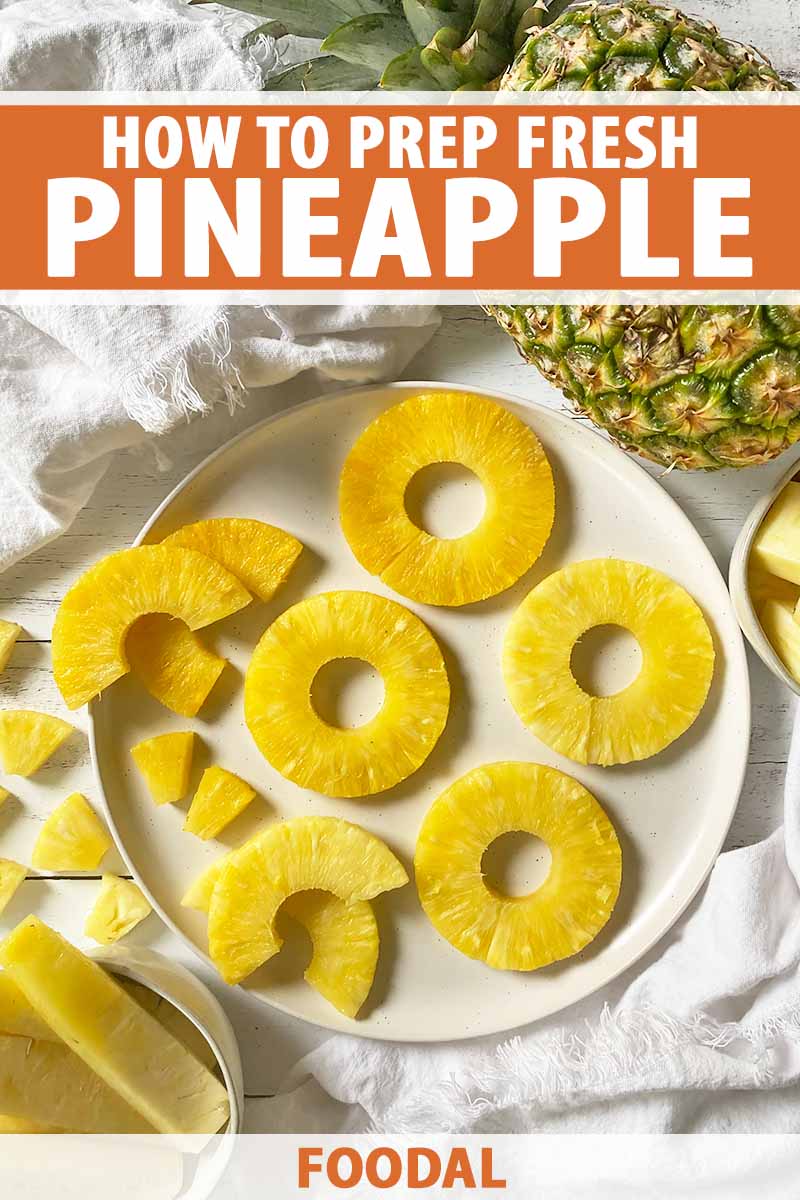
If you love eating fresh and juicy pineapple, but want to refine your knife skills in order to efficiently and confidently cut it at home, read this guide before your next trip to the produce department.
You don’t have to make a beeline to the prepared fruit section, where it is already cut into rings or cubes in rows of priced containers.
While they are admittedly convenient options, the cost will be significantly higher for these choices as opposed to bringing home a whole one. This is due to the added labor involved in preparing it for retail sale.
Save your money, and learn how to easily and quickly prepare the fruit at home with our tips and tricks guiding you every step of the way!
With a sharp knife as your reliable companion, you’ll be shocked to discover how swiftly you’ll be able to serve up expertly peeled and sliced fruit for everyone to enjoy at a fraction of the price.
How to Select, Cut, and Store Fresh Pineapple
Basic Information
The pineapple, Ananas comosus, is a tropical fruit indigenous to South America, and it has been domesticated across the globe in warm regions.
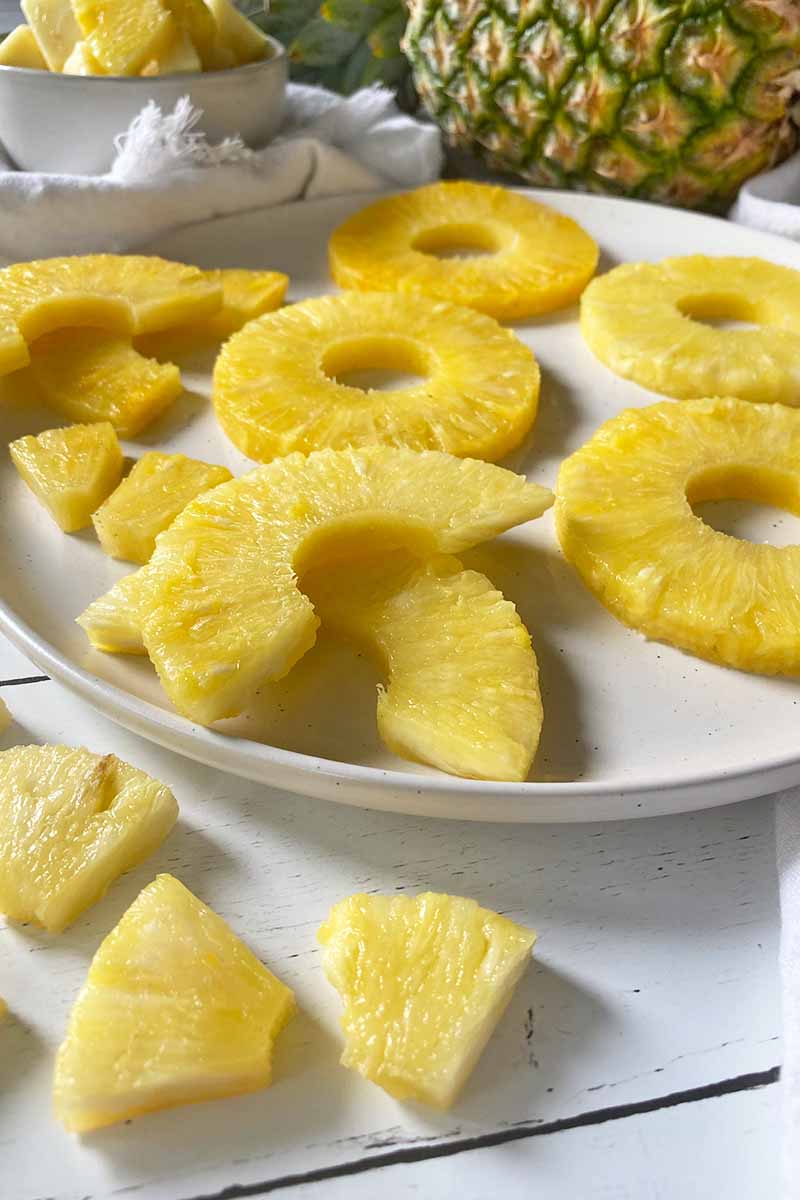
When left unpollinated, the individual flowers of the shrub on which pineapples grow form spirals of separate, seedless fruitlets, which fuse together and join to a central core which runs down the entire center of a single pineapple.
When looking at the exterior of a pineapple, you’ll be able to see these individual fruitlets in a diagonal diamond pattern.
Because they are non-climactic fruit, they will not continue to ripen or sweeten once harvested. They will continue to soften in texture and eventually decay.
At their very best and ripest, they are characteristically sweet and tart, with slightly fibrous yet soft flesh. They have a strong, fruity aroma with tropical notes.
There are many cultivars of the pineapple, each with its own nuances of flavor and aroma, and textural differences. Kona Sugarloaf, Natal Queen, Pernambuco, Red Spanish, and Smooth Cayenne are some popular cultivars.
As far as what is commercially available in the United States and sold in most grocery stores, a cultivar known as MD-2 has become the most common, a hybrid developed for its sweetness, low acidity, and resistance to browning when refrigerated.
How to Select
How do you know which pineapple is best to pick at the store?
There are a few key actions to follow when shopping for your produce!
Look
Do not rely solely on the color of the its skin, as not all ripe options will look bright and yellow on the exterior. Perfectly ripe options may be green, yellow, brown, or a mix of all three colors.
What’s also important other than color are visual signs of distress – look for bruises, soft spots, or mold. If you see any of these, put that selection back and continue your search for a fresh one.
You should also take a close look at the leaves, as the appearance of the crown will be another factor in determining its quality.
The leaves should be green and vibrant. Avoid any options that have brown leaves that are dry, soggy, or wilted – all signs that the fruit is in a state of decay.
Feel
The main body of the fruit should feel firm to the touch, yet it should yield just slightly when gently squeezed.
Push your fingers against it in various places. The skin should push in slightly, but it should not be excessively soft or mushy.
You can also feel how heavy a pineapple is – hold one in your hands, and consider its weight compared to others that are roughly the same size.
A heavier selection generally indicates that it has a high water content, meaning it will be juicy!
Smell
And, finally, smell the skin and crown. It should give off a slightly sweet and tropical aroma at its stem.
Is there no scent? This means it was picked far too early and won’t be ripe enough.
Is the scent off-putting? If there is a rotten or vinegary smell, or it has a stench that you negatively react to naturally, this means the fruit is too old.
How to Store the Whole Fruit
Fresh, whole pineapples can be stored at room temperature on your kitchen counter or dining table for up to one week before cutting.
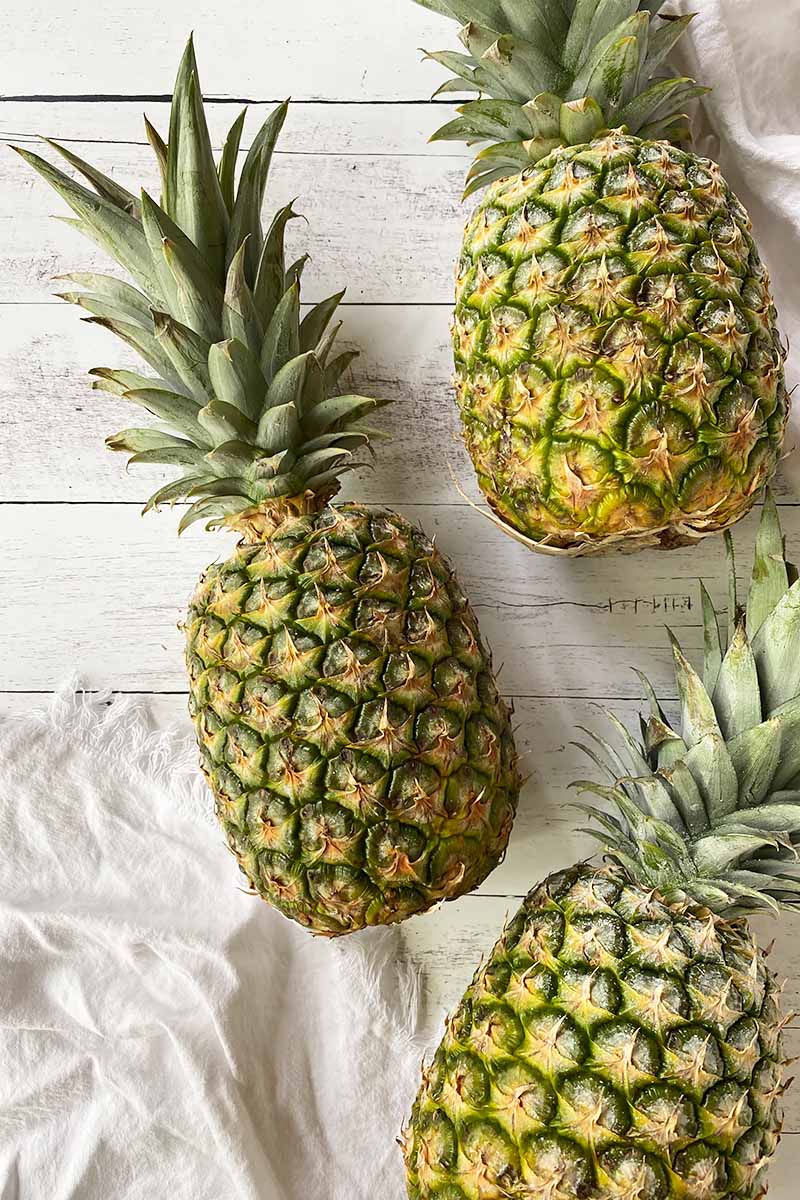
When uncut, the fruit will be perfectly fine to leave out at room temperature – a storage blessing for those of us who would never have that kind of room in our tiny refrigerators to store a whole fruit like that!
But there are a couple important factors to be mindful of when storing your fruit, which will influence its quality over this period:
The warmer or more humid your home is, the faster it will start to soften and eventually decay. On that note, try not to place your fruit near your stove and oven.
The longer you wait to prep your pineapple, the more it will start to soften, decay, and decline in quality.
Try not to forget about it and be sure to cut it within a week of purchase – it’s helpful to set yourself a reminder on your calendar.
And no, we are not joking about that! Stay organized!
How to Peel and Cut
One beautifully fresh pineapple chosen and bought: check!
You’re now just a few minutes away from enjoying sweet pieces of juicy fruit!
Next, you’ll learn how to peel and cut your pineapple with a chef’s knife, a technique that is best for cutting spears or chunks.
Step 1 – Prep
Set out a large, sturdy cutting board, a large chef’s knife, a small paring knife, two large bowls, and multiple kitchen towels.
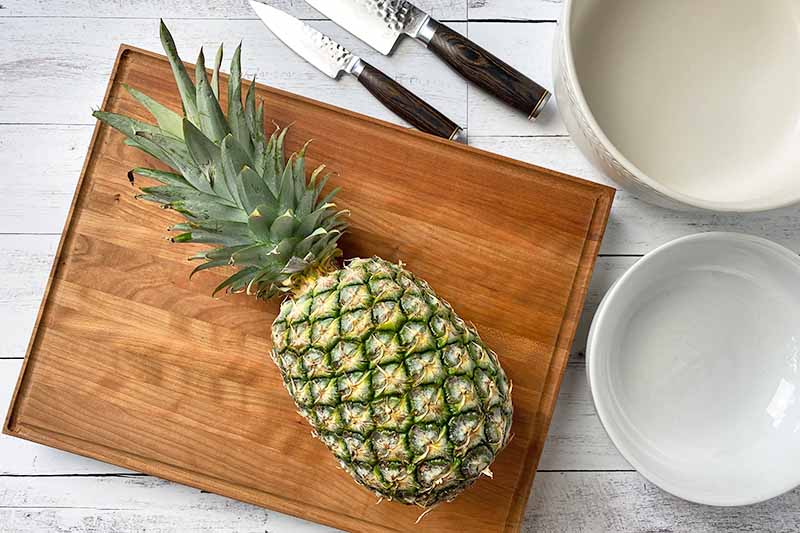
One bowl will be for collecting any scraps, while the other will be for collecting all of the edible pieces. And the kitchen towels will be for cleaning up the mess!
For the safest procedures and cleanest cuts, your knives should be honed and sharpened prior to use.
Briefly rinse the entire pineapple under cold, running water to wash off any dirt or debris.
Shake off any excess water in the sink, and pat the exterior of the fruit with a clean kitchen towel to dry it off as much as possible. Place the fruit on its side on the cutting board.
Step 2 – Cut off the Crown and Bottom
Use your chef’s knife to completely slice off the green crown at the top of the pineapple, slicing about 1/4 inch below where the leaves meet the top.
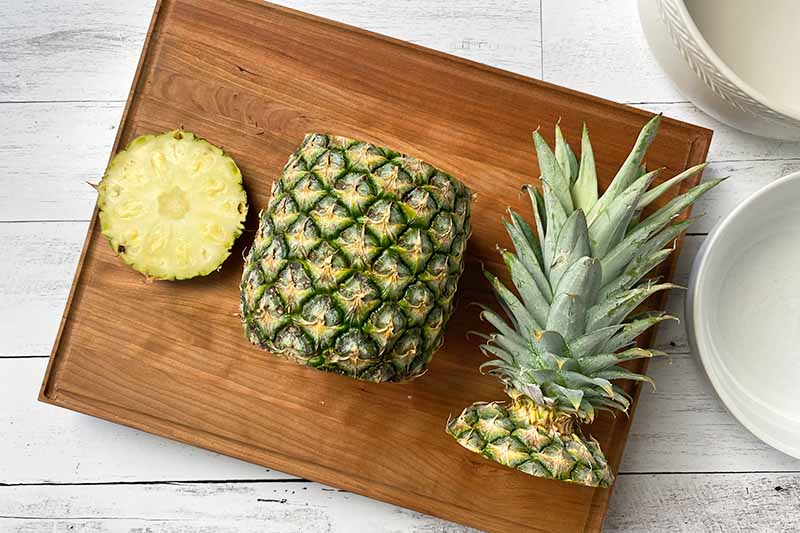
Dispose of the crown, or use it to sprout a new plant. This can be a fun project to do with the kids, and you can read more on our sister site, Gardener’s Path.
Completely slice off the bottom stem end, slicing as evenly as possible to create a flat, stable bottom. Dispose of this end.
Step 3 – Slice off the Skin in Strips
Stand the unit upright, with the crown end facing up and the bottom end on the cutting board.
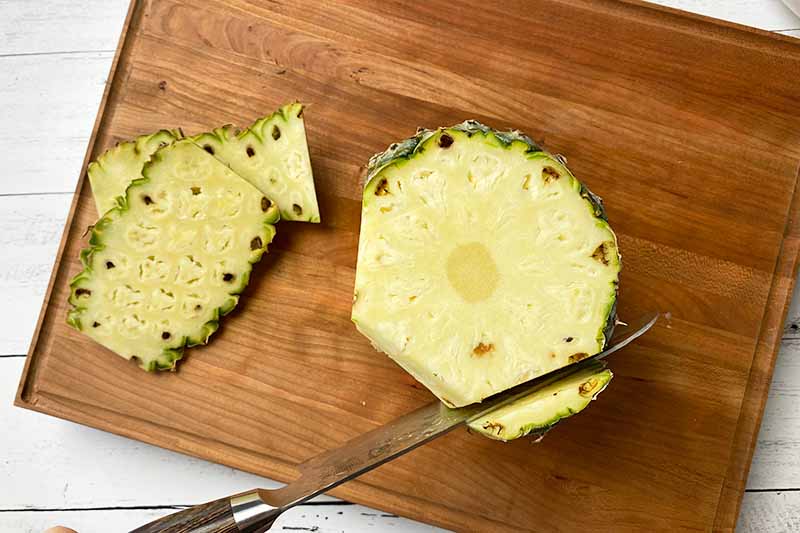
Using your chef’s knife, slice off the fruit’s skin from top to bottom in vertical slices, cutting just deeply enough to remove the skin without taking off too much flesh.
The slices should be thick enough to remove both the skin and most of the brown, speckled spots directly underneath the skin.
Often referred to as “eyes,” which are harmless parts of each individual fruitlet, you can slice off any of these remaining spots with your paring knife.
Dispose of any inedible parts.
Step 4 – Quarter the Fruit
You now have a beautifully peeled single unit of fruit! Now, let’s get to dividing it.

Keep it standing upright. With your chef’s knife, halve the entire fruit lengthwise, from top to bottom. You will cut through the core of the pineapple.
Halve each of these two pieces again lengthwise, from top to bottom.
You now will have four equally cut wedges, each with some of the core still attached to the flesh.
Step 5 – Slice the Core from Each Quarter
The core is very fibrous and much harder in texture than the flesh, and it will need to be removed prior to consumption.

Work with one quarter at a time. Stand one quarter upright, and use your chef’s knife to make one single cut downwards from top to bottom to separate the core from the flesh.
Try to only cut the core away, without removing too much of the flesh. The core will be a slightly lighter, whiter color than the flesh, so you will be able to identify where to place your knife before you slice.
Repeat with the remaining quarters, disposing of the core pieces.
Step 6 – Cut Pieces to Desired Size
You may now cut each quarter to your desired shape and size!
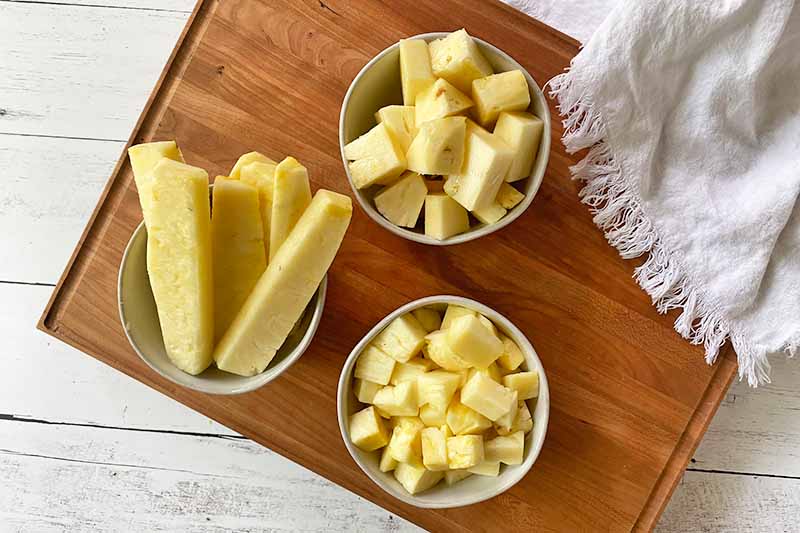
You can cut the flesh into long spears, or you can choose to cut it into cubes.
How to Use a Pineapple Coring Tool
Do you prefer perfectly round, beautiful rings? Don’t want to deal with the hassle of peeling everything with a knife?
You might appreciate the convenience of a coring tool!
We’ll detail the basic steps for operating a pineapple corer, which is generally a simple T-shaped device composed of a long cylindrical metal ring, with a metal blade on the bottom and a handle at the top.
The operating instructions may vary slightly from what’s described here, depending on what brand you decide to purchase.
For this article, we will be using the OXO Stainless Steel Pineapple Slicer, with a ratcheting handle.
OXO Stainless Steel Pineapple Slicer, available on OXO
The measurement markings on the blade are a helpful feature, allowing you to clearly identify your fruit’s height before slicing – you’ll know when you’re getting close to the bottom of the fruit as you’re operating the tool.
Interested in adding one of these to your kitchen toolkit? You can purchase this slicer directly from OXO, or you find it on Amazon.
Step 1 – Prep
Set out a large, sturdy cutting board, two large bowls for the prepped fruit and scraps, a chef’s knife, and multiple kitchen towels. Set out your coring tool.
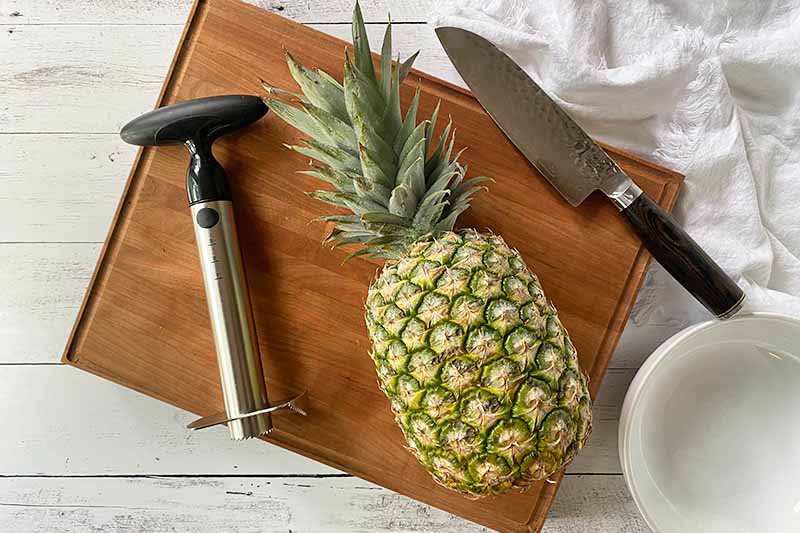
Briefly rinse the entire unit of fruit under cold, running water to wash off any dirt or debris.
Shake off any excess water in the sink, and pat the exterior of the fruit dry with a clean kitchen towel. Place on its side on the cutting board.
Step 2 – Cut off the Crown
Use your chef’s knife to slice off the crown with the leaves attached at the top of the pineapple, slicing about 1/4 inch below where the leaves meet the top of the fruit.
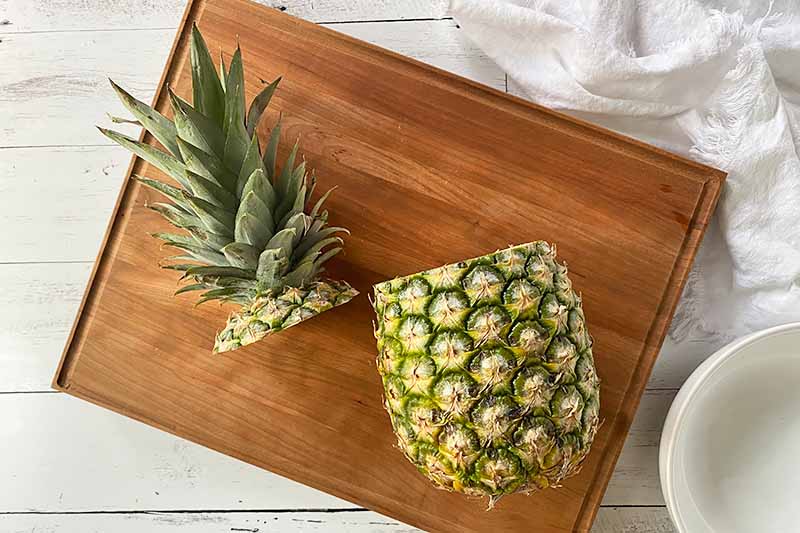
Dispose of the crown.
Step 3 – Press the Coring Tool Down While Twisting
Stand the pineapple upright, with the cut side facing upwards.
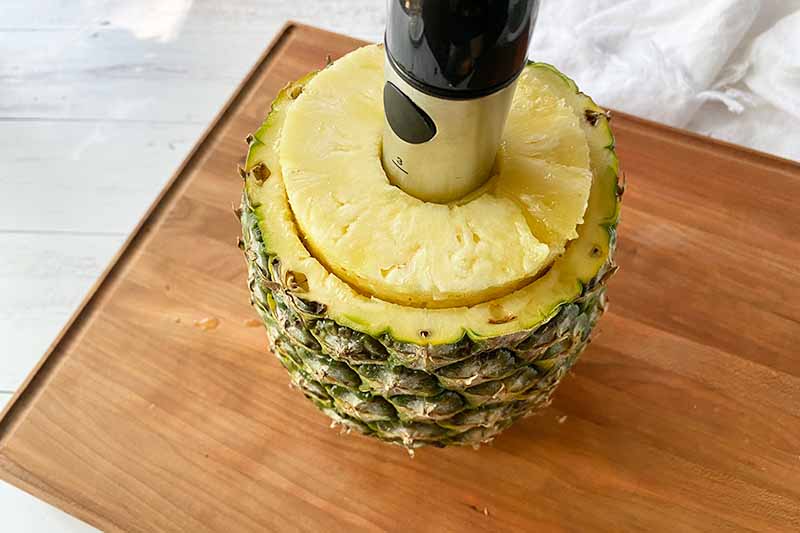
Center the blade of the corer directly in the middle of the exposed flesh on top, in line with the fruit’s core.
Using the handle to twist, move the blade downwards to a point that almost reaches the bottom of the pineapple.
Step 4 – Pull Up to Remove Cored Flesh
With one hand on the fruit and the other on the tool, pull the corer upwards to completely remove the flesh from the exterior.
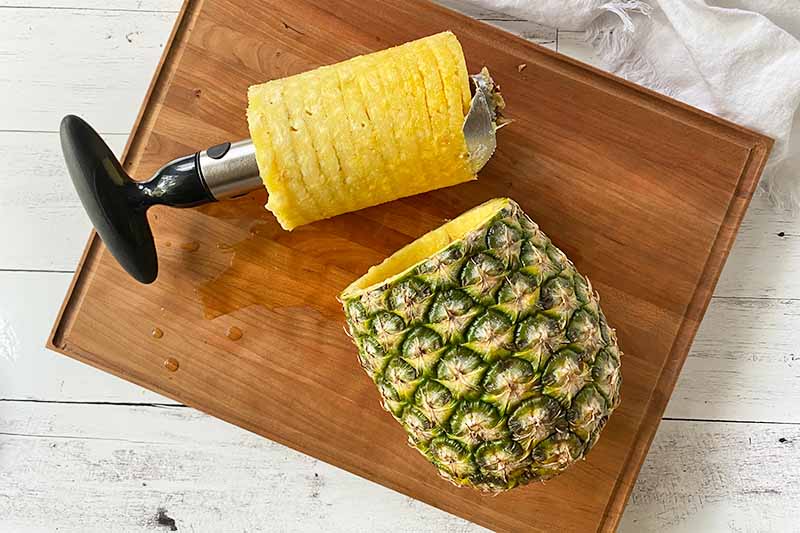
Dispose of the core and the skin in a separate bowl. You could also save the shell, if it has remained in one piece. This hollow bowl can be used as a fun serving vessel!
Step 5 – Release Flesh from Coring Tool
Push the release button, or whatever mechanism your tool has to remove the flesh from the blade.
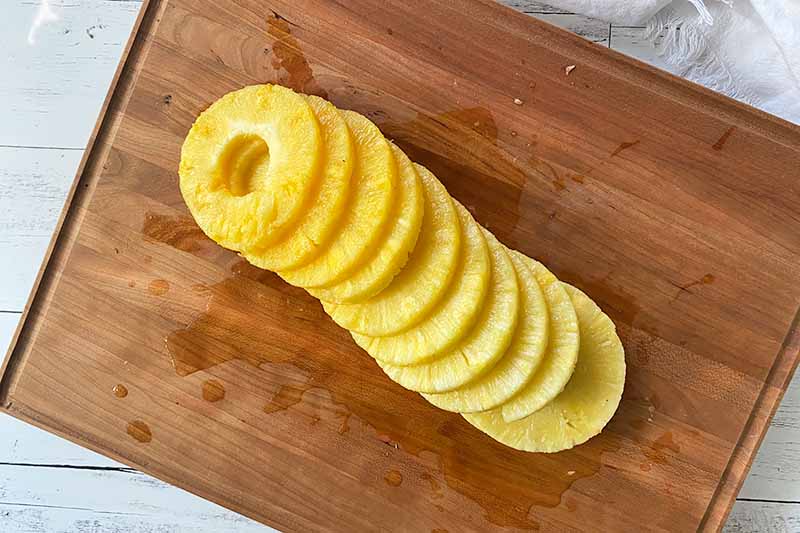
The flesh will often be in the form of one long spiralized piece – just like a Slinky!
Step 6 – Cut Pieces to Desired Size
You may now cut the flesh into your desired shape!
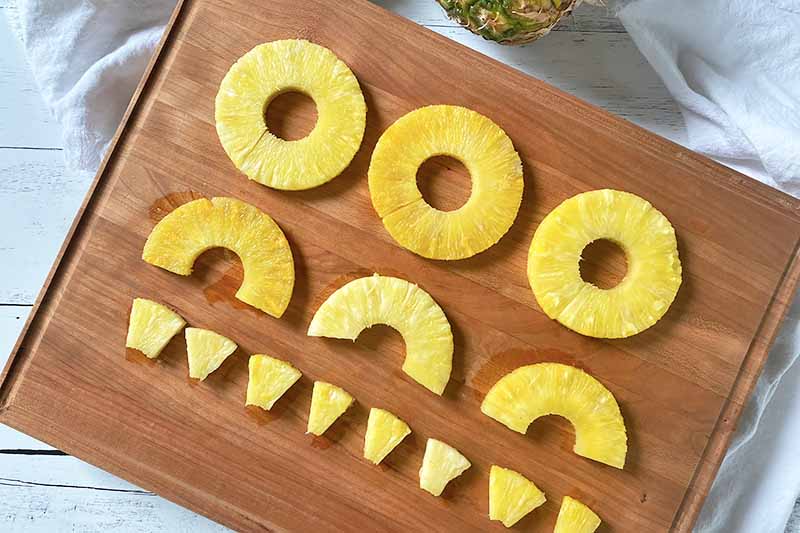
You can section off the long spiral into individual rings, or break them down even further into large or small pieces.
How to Store Cut Pieces
Freshly cut pineapple will keep in your refrigerator for three to five days when stored properly in an airtight container.
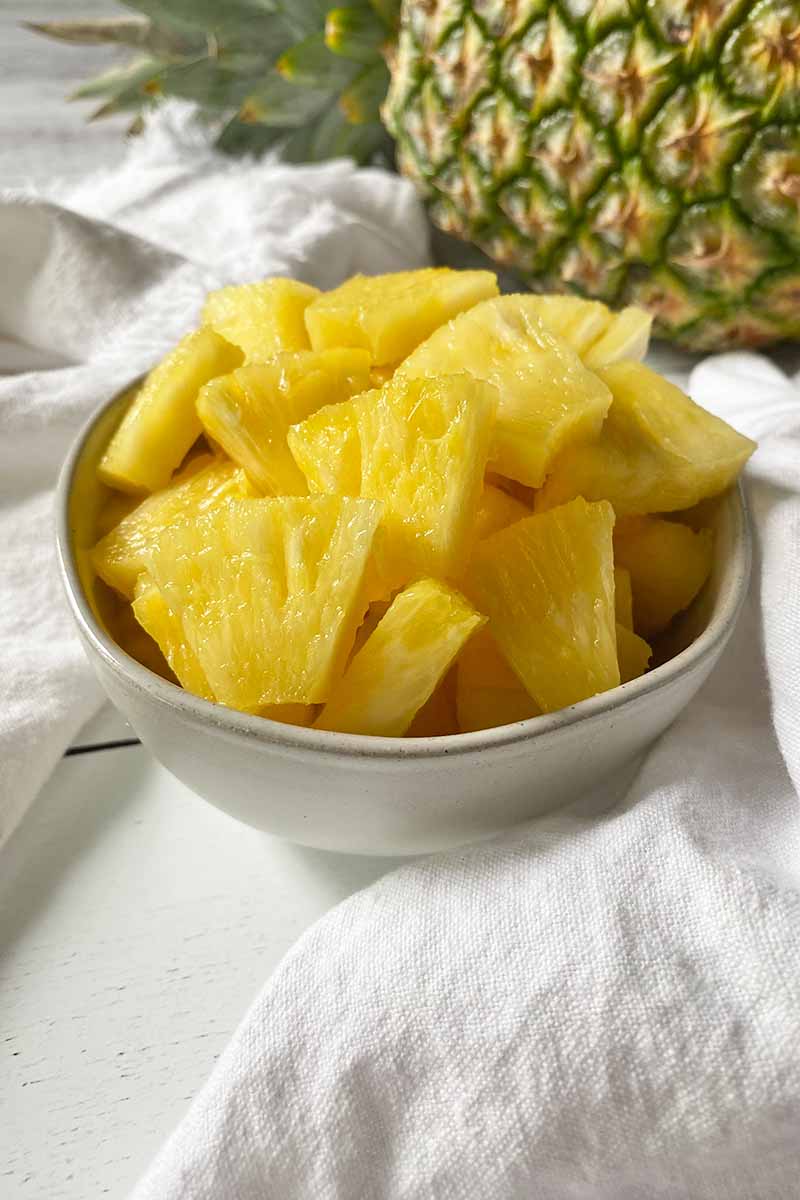
You can also choose to juice it with an electric juicer – carefully follow the instructions provided by the manufacturer of your appliance.
Fresh juice will keep in the refrigerator for up to three days in an airtight container.
You can also extend the life of your fruit by freezing the pieces or juice – a perfect choice for meal prepping!
For juice, simply transfer the liquid to a freezer-safe airtight container and store it in the freezer.
For pieces, to ensure they won’t stick to each other when they are frozen – what a nuisance! – you need to strategize.
Instead of throwing them all in a bag in the freezer directly after cutting, you should place the chunks on a baking sheet lined with parchment paper, leaving enough space in between each piece so they do not touch.
Transfer the baking sheet to the freezer uncovered. Freeze on the baking sheet until each piece is completely frozen, for about two to three hours.
This step is essential to prevent them from sticking together when you transfer them to a container.
And be sure to use an airtight container or bag that is safe for the freezer – this will keep your cut pieces safe, and will prevent freezer burn.
Frozen pieces and juice will keep in the freezer for up to six months.
How to Serve
While delicious when served fresh on its own, pineapple can be fried, grilled, pureed, sauteed, baked, and more. Below we offer a colorful variety of serving suggestions to try – but the inspiration is nearly endless here!
Ready to start your day in the brightest way? Begin your morning with these sweet breakfast ideas where you can include this fruit:
- Along with strawberries, bananas, grapes, kiwi, blueberries, apples, and tangerines, pineapple brings a sweet boldness as one among the many fresh components in our summery mixed fruit salad. Serve it as a light and healthful breakfast.
- Make a layered breakfast parfait with yogurt and freshly cut chunks, and garnish the top with crunchy granola.
Pineapple can be blended to make so many fun and refreshing drinks! Be inspired by these ideas to quench your thirst with something tasty:
- Whizz frozen chunks into fresh smoothies with your blender, like our dairy-free pineapple coconut smoothie.
- Juice a fresh pineapple, and save a few chunks as a garnish, to serve our tropical lemonade that you and your buddies can enjoy all summer long at barbecues and pool parties.
Pineapple offers a sweet, tart, and acidic balance to savory meals. Try it now for lunch or dinner with these recipes:
- Use fresh juice in the marinade for our Hawaiian grilled chicken thighs, and serve them alongside grilled rings or chunks.
- In a rush? Make our 5-ingredient Thai curry when you’re in a hurry! The simple sauce is a quick mix of canned coconut cream, red curry paste, fish sauce, chili flakes, and chopped pineapple.
- For bite-sized finger food, our tropical chicken cups will be a fun addition to any festive event.
And always save room for dessert! Try these ideas:
- Make a double-decker showstopper with our cream cheese, raspberry, and pineapple quesadilla.
- To beat the heat, wave away the ice cream truck in favor of our homemade ice pops, made using fresh fruit juice.
Which recipe will you choose first?
An Easy DIY Project
See? There’s nothing overwhelming or difficult about selecting, storing, and preparing fresh pineapple all by yourself!
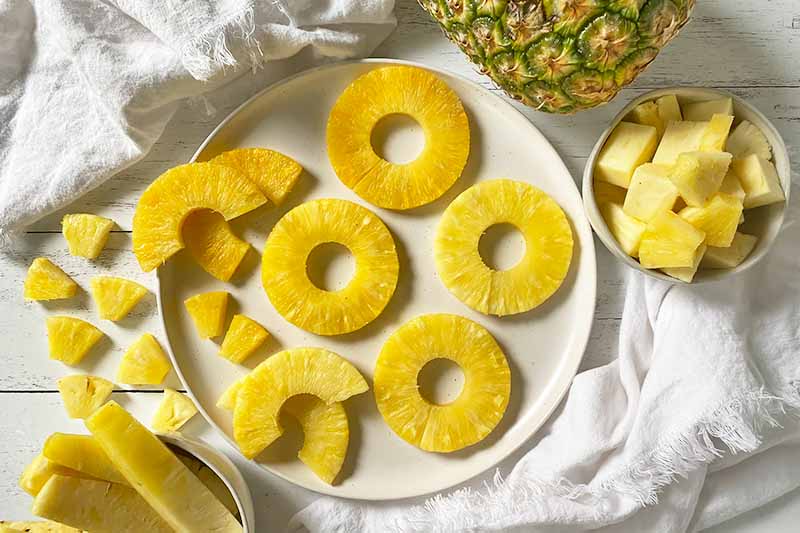
And it can all be done with a discerning eye at the grocery store, mindful storage methods, and just a few swift slices of a knife.
When you take the prep responsibilities into your own hands, you’ll be able to enjoy the freshest results, and you’ll be saving some money – no more expensive pre-sliced fruit!
Do you have a prep technique you prefer? Do you like using your knife for every cut, or do you appreciate the extra help from a corer? Let us know in the comment section below.
Have we boosted your confidence with this tutorial? Let’s review some other basic kitchen prep tasks and basic knife skills with more ingredients you know and love! Choose what interests you the most from our selection of how-to articles, starting with these:
Photos by Nikki Cervone, © Ask the Experts, LLC. ALL RIGHTS RESERVED. See our TOS for more details. Product photo provided by OXO. Originally published on September 14, 2014. Last updated on July 7, 2023.
About Nikki Cervone
Nikki Cervone is an ACS Certified Cheese Professional and cheesemonger living in Pittsburgh. Nikki holds an AAS in baking/pastry from Westmoreland County Community College, a BA in Communications from Duquesne University, and an MLA in Gastronomy from Boston University. When she's not nibbling on her favorite cheeses or testing a batch of cupcakes, Nikki enjoys a healthy dose of yoga, wine, hiking, singing in the shower, and chocolate. Lots of chocolate.

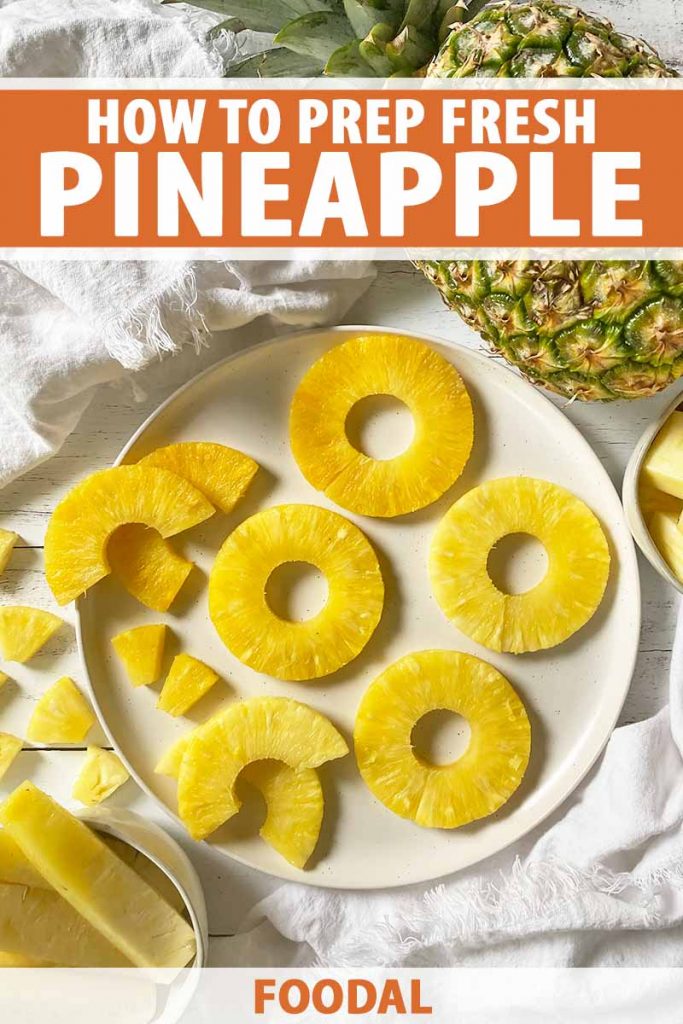

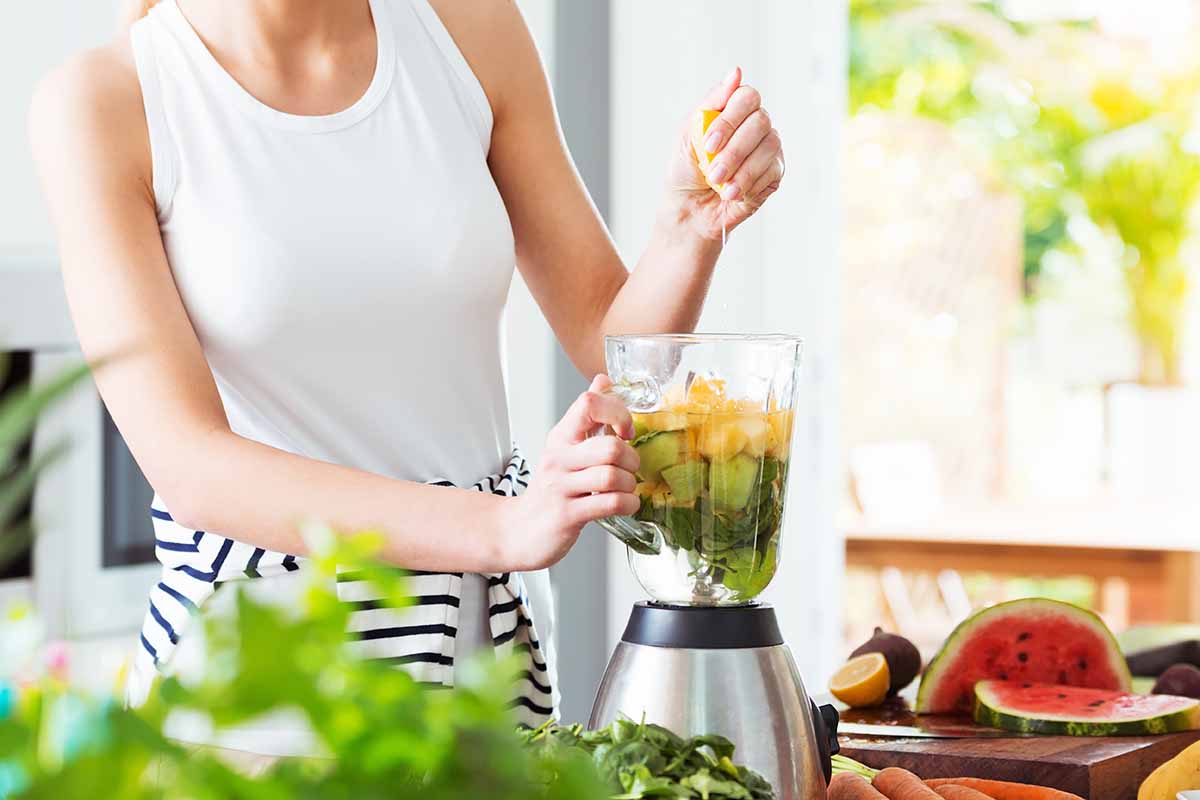

Have you seen those pineapple cutters that make the process of cutting and coring so much quicker? I was a non-believer until I picked one up for a couple bucks – it makes a world of difference! Plus, all the juice stays in the pineapple while you’re doing it so you can use it for something else (or drink it like I do )
I have never seen those. I will be on amazon.com in a little while searching for one. Fresh pineapple- can’t beat it.
I have always wondered if those pineapple cutters worked! I have always done it by hand myself but it can be time consuming. I have actually had the Kona Sugarloaf variety in Hawaii and it was so delicious. I have not tasted a pineapple like the ones I had in Hawaii. Until I went there I did not know what the plant even looked like! Did you ever try Dole Whip pineapple ice cream? I had it as much as possible!
I am going to try planting my own next time I get one!
Very informative. The other day at the grocery store my husband and I wanted to purchase a pineapple but couldn’t agree on how to know which to select. Now I know! I’ll have to show him this. Looks like we are having pineapple this week!
Thank you for this post! I don’t know why picking out pineapples is such a mystery to me. Perhaps because I don’t buy them often. I have purchased several over/under ripe ones before. I love pineapples as a treat–they’ve got a unique taste and are great on their own or in savory recipes.
Pineapple is one of my favorite fruits. It’s so refreshing, especially during the summer months. I usually eat them freshly sliced raw, or sometimes with salt… if we have a BBQ I also like lightly grilled pineapple.
Picking pineapples has always been so hit or miss for me. Now, I know exactly what to look for. I love to make pineapple upside down cake with fresh pineapple instead of pineapple from a can. It tastes so much better.
This was really helpful, thanks a lot! I love fresh pineapple, but between choosing it and cutting it, it always seemed like too much trouble, but you make it really simple! I can’t wait to try this.
I used to serve a sugary dessert after dinner every night. It wasn’t good for our health, so I slowly started serving puddings and Jellos instead. Now I’m transitioning to serving fruit every night, and pineapple is definitely the family favorite.
I’ve been buying it canned and serving it right out of the can, leaving it in the fridge before serving so it’s chilled. I think now I’m feeling more inspired to buy some fresh. The only thing that kept me from buying fresh was I wasn’t sure how to cut it up. It doesn’t look too hard. I like the idea of using a paper bag to sop up all the extra liquid. That should make for a much easier cleanup.
We delighted on pineapples for lunch on today, My Mom and I. I always eat the fresh pineapples because the canned varieties are awful.
I used to struggle so hard as a child using a blunt knife, you absolutely have to have a good, long sharp knife. I love the mix of pineapple and cheese on a cheese board.
Wait a minute…you mean one can mix pineapple and cheese together?…how is the taste like?…being too conservative is my main problem, i ought to change and get off my comfort zone once in awhile 🙂
Wonderful nugget of knowledge right there, next time am out grocery shopping, pineapples will be at the top of my list, And am saving the crown, plant it in my friend’s backyard…i believe we’ll both benefit 2 years down the line and in the process save us some pocket money 🙂
I actually think the pineapple tastes better when it is yellow. For me, it is like choosing a banana when it is slightly ripe with brown spots. It has more flavor. But to each his own.
I think someone once told me that to select a pineapple, you had to pluck one of the leaves and if it came out easy, it was ready! Someone else announced it was false a few years after. Your tricks sound legit — though really? They are ripe in the grocery already? I remember a few times I had cut into my pineapple too early and it was a bit on the hard side rather than sweet and juicy!
I love pineapple in some fried rice 🙂 It just makes the mix of salty a bit sweet and fresh, yummy!
This is an awesome article. I find every time I go to the grocery store I am kicking myself in the butt for not researching what each fruit/vegetables looks like when it is ready to eat. I actually didn’t know that when a pineapple arrives at the grocery store, it is already ripe. Now I am laughing at all the time I spent trying to pick the”ripe” one. haha anyways. awesome article thank you!
Thank you for the lowdown. I’ve never had much sucess with buying fresh and now I know why! Whilst I love the taste of pineapple, I only ever have it from a tin. Now I know what I’m looking for, I can look forward to incorporating fresn pineapple into more of my dishes.
This is a very helpful article. I buy pineapples from a local organic farm and it’s hard to figure out whether one will be a “winner” or not. The last one I ate tasted really odd, almost like it had absorbed some odors from old food or something! I wasn’t really sure what the problem was so I ended up throwing it out. Sadly, I had purchased another one at the same time and I still haven’t cut it up to see if it has a good flavor or not…I’m hoping that it tastes much better. My fiancé suggested that we leave it in the fridge for a few weeks to see if the other one just wasn’t ripe…but now that I’ve read your article, I’m guessing that wasn’t the case! Maybe it had just been a bit old?
So I noticed that you cut the top of your pineapple first. I’m guessing that means you’ve never seen a pineapple street vendor in South East Asia lol.
Here’s a tip: to keep your hands clean, cut the outside of the fruit first, THEN cut the top off. That way, you have something to hold onto while you’re cutting the spiky exterior
If South Korea and China counts as South East Asia, then yes, I’ve seen them. Thanks for the tip though.
When I was younger, I remember my mom used to get us (me and my older brother) pineapple every Monday when we woke up and occasionally on Fridays to remember us about the sweet Mondays we passed. It was our favorite morning “snack”. It also helped us get up for school, One time, she cut it up so badly I refused to eat it and she kind of got mad at me afterwards, haha.
I’m excited, I just used this guide to cut one up, and am rooting the crown. I love pineapple, and am looking forward to eating this, as well as hopefully growing one in the future, if it takes root.
I actually have a tip about pineapple & how to get the best pieces out of one. So, when the pineapple is being transported & stored it’s usually upright. Which lets the juices settle in the bottom of the pineapple & can result in dryer pieces toward the crown. If you buy your pineapple, slice off the crown, & flip it upside down letting it rest that way the juice will filter back through the pineapple. Mmm.
This is by far my favorite fruit; I love the wild flavors that I get every time I bite into a chunk. I really want to try growing my own pineapples now, though I’m sure they wouldn’t be half as good as the ones in Hawaii (I live in Florida). I can attest to bananas being delicious with pineapples; those two fruits are usually what I use in smoothies.
Very informative article. I’ve never dared to buy fruit myself because I could never tell which was fresh, juicy or sweet. My mom always did that for me but after reading this article, I’m interested in picking out pineapples myself. I’ve eaten many pineapples across the world and by far the country with the best pineapple for me is Taiwan. Sweetest and juiciest pineapple you’ll ever have. America’s pineapples are just kinda sour to me, so I never really eat them.
This is good to know. I usually am pretty good at picking ripe fruit. This one I always just grab what looks good and let it sit for awhile. I see that it is good to let it get golden. Yellow and slightly soft is not something I let it do so this should be really good now to try. The slicing method looks good too. I like to watch videos on techniques for this. It’s always good to see different ways to find what’s best.
I never knew how many types of pineapple there were! That’s amazing. Do they all have a different taste? My boyfriend considers himself a pineapple addict, me, not so much. So being able to tell when they are ready to be cut and devoured, or even just knowing which of the fruits to stay away from or not waste money on is a blessing in disguise.
Fun fact about pineapples; every pineapple takes 2 years to grow, that’s quite a long process but the fruit is really unique. I never knew how to determine if a pineapple is fresh or not, never really thought about it. Thank you for the tips, it was very helpful!
I love eating this fruit. My mom tends to take sliced pineapple and then put on the ham to bake in the oven. I have seen it on TV how people tend to grill pineapples. The funny thing is that I won’t eat this fruit on top of pizza. These flavors combined just throw my taste buds off.
Thank you for the advice. I usually buy the pineapples that come in cans, or the ones that have already been sliced, because I didn’t know how to differentiate the fresh from the not so fresh. I also didn’t know there were so many types of pineapples. Now I want to try them all!
Great article! I knew about checking pineapple leaves, but I had no idea that when the fruit is in the store, it can be considered ripe. I love pineapple, and I would have been buying fresh ones much more often had I known..
Pineapple is one of my favorite fruits. I’m a sucker for the acidity-side of the fruit spectrum. Though I usually buy tinned or fresh, pre-cut pineapple, this guide will help me in the future.
Pineapples are delicious and so healthy too! They can be eaten with any meal and are especially good with meat, especially on pizza. I love the taste of pineapple and a little natural juice is also excellent for your skin as it contains anti-aging acids that will speed up dead skin elimination.
Definitely one of my favorite fruits. It is very versital and works great with chicken, to make sauces, with pork and of course fresh chunks in fruit bowls or in smoothies. In central america, the pinapples are very different than can be found in Hawaii or supermarkets in the USA, which are golden pinapples. Here they are much whiter inside and have a more fibrous texture and are less flavorful, so you have to cook them a bit differently. But on the good side, they are basically free here, costing just pennies each.
The pineapple slicer is actually a very useful thing to have on hand, and I am kind of upset that I do not have one yet. I used o work at a place that had,one, and my pineapple intake was a lot more, but now I do not eat as much as I would like to. It is pretty cheap this time of year though, so I will have to go out and finally get one of those.
I live in South Africa in Kwa-Zulu Natal, home to… you guessed it, the Natal pineapple! We have several growing in the garden which we have propagated from locally purchased (and otherwise devoured) fruit. They grow like a dream, but alas, along with the climate they do so well in, we also have Vervet monkeys that somehow always manage to grab them just before they’re ripe enough to pick! Oh well! Thanks for a great article.
This is quite informational. I have the hardest times picking out pineapple while I am at the store. I can’t ever tell if they are under-ripe or perfectly ripe, or even too ripe. No one ever tought me how to check a pineapple! Though, on the times we cut into a fresh, ripe pineapple, we just cut it into chunks and serve it and it gets eaten right away!
thank you foodal for giving me wonderful information
You’re welcome! Thanks for reading!